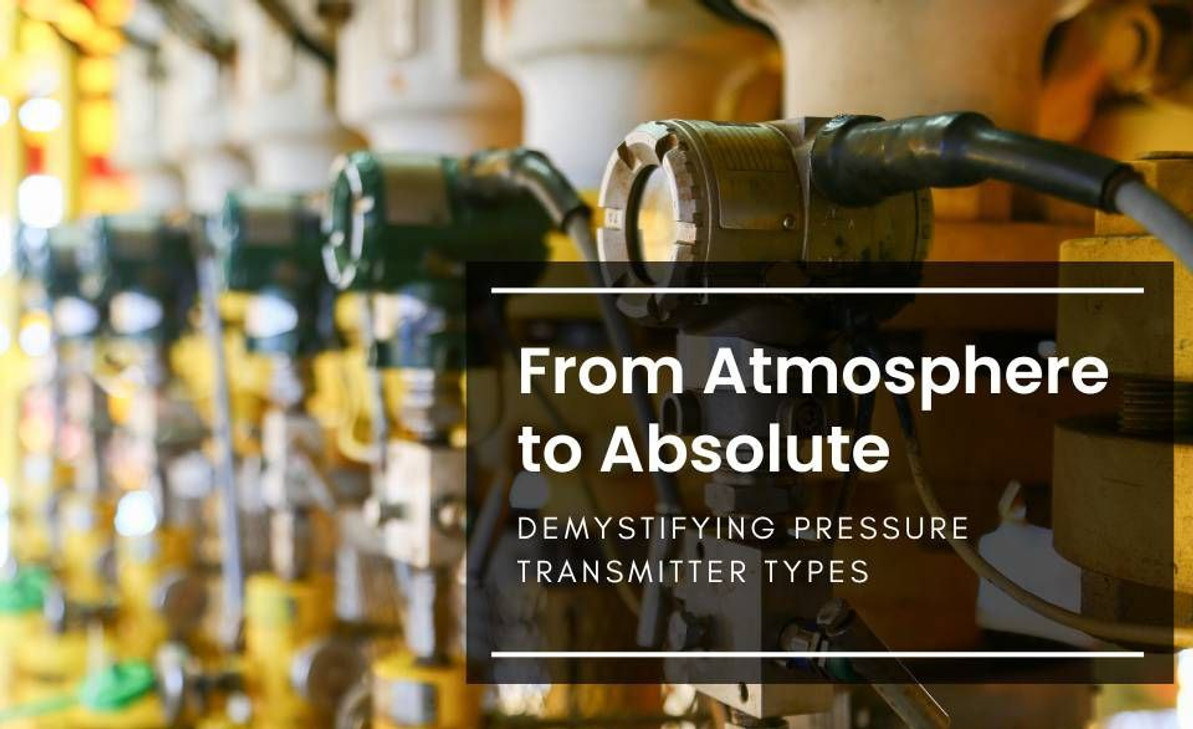From Atmosphere to Absolute: Demystifying Pressure Transmitter Types
Pressure transmitters are integral devices in various industries and applications, playing a crucial role in monitoring, controlling, and ensuring the safety of processes and systems. They are designed to measure pressure and convert it into an electrical signal, allowing for accurate and real-time pressure monitoring. Understanding the different types of pressure transmitters, their working principles, advantages, and disadvantages is essential for selecting the right one to meet specific application requirements.
In this comprehensive guide, we delve into the world of pressure transmitters, exploring the intricacies of Absolute Pressure Transmitters, Gauge Pressure Transmitters, and Differential Pressure Transmitters. We uncover the working principles behind each type, unravel their distinctive advantages and limitations, and examine the critical factors that influence their selection. Moreover, we provide real-world examples and scenarios to illustrate how these pressure transmitters find their place in a wide range of industries and applications.
By the end of this guide, you'll be equipped with the knowledge to make informed decisions when it comes to choosing the appropriate pressure transmitter type for your unique needs. Whether you're working in the realm of industrial processes, scientific experiments, meteorology, or any other field, the insights offered here will empower you to harness the power of pressure measurement with precision and confidence.
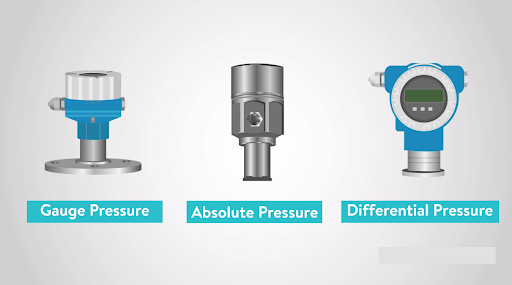
Fig 1. Pressure transmitter types
Absolute vs. Gauge vs. Differential Pressure Transmitters
Pressure transmitters are instruments used to measure and transmit information about the pressure of a fluid or gas in a system. There are three common types of pressure transmitters: Absolute Pressure Transmitters, Gauge Pressure Transmitters, and Differential Pressure Transmitters. Each type is used in specific applications and provides different information about pressure. Here's an overview of each type:
Absolute Pressure Transmitters:
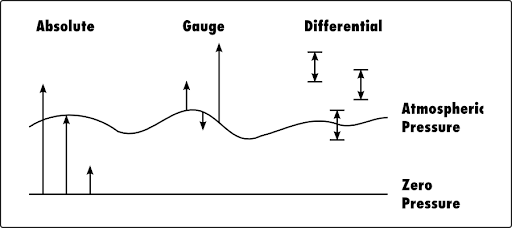
Fig 2. Different pressure types
What is an Absolute Pressure Transmitter?
An Absolute Pressure Transmitter is a type of pressure sensor or transducer designed to measure and transmit pressure readings relative to an absolute vacuum, as opposed to measuring pressure relative to atmospheric pressure or any specific reference point. In other words, it provides a measurement that includes the absolute zero pressure point.
Here are some key characteristics and uses of Absolute Pressure Transmitters:
- Reference to Absolute Vacuum: Absolute pressure transmitters measure the pressure of a fluid or gas relative to a perfect vacuum (zero pressure). Unlike gauge pressure transmitters, which measure pressure relative to atmospheric pressure, absolute pressure transmitters account for the entire range of pressure values, from absolute zero to the pressure of the medium being measured.
- Common Uses:
- Meteorology: Absolute pressure measurements are important in meteorology for weather forecasting and studying air pressure systems.
- Altitude Measurement: In aviation and aerospace, these transmitters are used to determine altitude above sea level.
- Scientific and Laboratory Applications: Absolute pressure transmitters are used in scientific experiments and laboratory setups where precise pressure measurements are crucial.
- Certain Industrial Processes: Some industrial processes require absolute pressure measurements, especially when dealing with vacuum systems and chemical reactions at specific pressure conditions.
- Atmospheric Pressure Compensation: It's important to note that absolute pressure transmitters can provide readings that are not affected by changes in local atmospheric pressure. Gauge pressure transmitters, on the other hand, provide pressure readings relative to local atmospheric pressure and are affected by atmospheric pressure variations.
- Pressure Units: Absolute pressure transmitters typically provide readings in units such as pascals (Pa), bar, psi (pounds per square inch), or millimeters of mercury (mmHg). The specific unit used can vary depending on the application and industry standards.
In summary, Absolute Pressure Transmitters are valuable instruments for applications where the precise measurement of pressure relative to a complete vacuum is necessary. They are commonly used in meteorology, aerospace, and various scientific and industrial processes requiring accurate and absolute pressure readings.
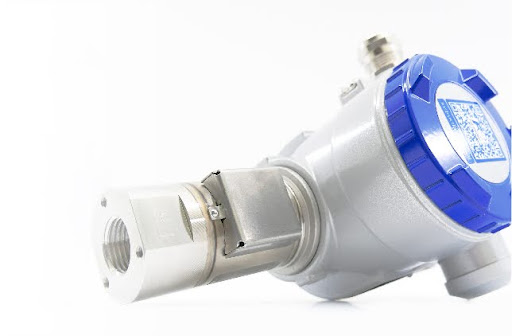
Fig 3. An absolute pressure transmitter
What is a Gauge Pressure Transmitter?
A Gauge Pressure Transmitter is a type of pressure sensor or transducer designed to measure and transmit pressure readings relative to local atmospheric pressure. It is one of the most common types of pressure transmitters used in various industrial and commercial applications. Here are some key characteristics and uses of Gauge Pressure Transmitters:
- Reference to Atmospheric Pressure: Gauge pressure transmitters measure the pressure of a fluid or gas relative to the local atmospheric pressure. In this context, "gauge pressure" refers to the pressure above or below atmospheric pressure. When the measured pressure is equal to atmospheric pressure, the gauge pressure reading is zero.
- Common Uses:
- Industrial Monitoring: Gauge pressure transmitters are widely used in industrial applications to monitor and control processes, such as in pipelines, tanks, and pneumatic systems.
- Pressure Safety: They are often employed to ensure that pressure levels in systems remain within safe operating ranges.
- HVAC Systems: In heating, ventilation, and air conditioning (HVAC) systems, gauge pressure transmitters monitor and control air and refrigerant pressures.
- Automotive: In vehicles, they are used for tire pressure monitoring systems (TPMS) to indicate when tire pressure is too low.
- General Pressure Measurement: Many pressure measurement applications require the comparison of the measured pressure to atmospheric pressure, making gauge pressure transmitters appropriate.
- Atmospheric Pressure Variation: Gauge pressure readings are affected by changes in local atmospheric pressure. Therefore, they are ideal for applications where you need to know the pressure differential from the local environment.
- Pressure Units: Gauge pressure transmitters typically provide readings in units such as psi (pounds per square inch), bar, kPa (kilopascals), or other pressure units relevant to the specific application.
In summary, Gauge Pressure Transmitters are commonly used in a wide range of applications to measure and monitor pressure relative to local atmospheric conditions. They are valuable for ensuring the safe and efficient operation of industrial processes and systems, as well as for applications like tire pressure monitoring in vehicles.
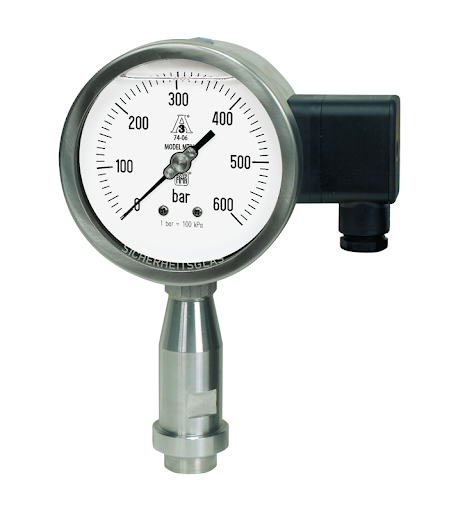
Fig 4. A gauge pressure transmitter
What is a Differential Pressure Transmitter?
A Differential Pressure Transmitter is a type of pressure sensor or transducer designed to measure and transmit the difference in pressure between two points in a fluid or gas system. This type of pressure transmitter is used to monitor changes in pressure between two reference points and is widely employed in various industrial and commercial applications. Here are some key characteristics and uses of Differential Pressure Transmitters:
- Measurement of Pressure Difference: Differential pressure transmitters measure and provide output signals that represent the pressure difference (delta P) between two points in a system. They typically have two ports, with one port connected to one reference point and the other port connected to a different reference point within the system.
- Common Uses:
- Flow Rate Measurement: Differential pressure transmitters are frequently used to determine flow rates in pipes and ducts. The pressure drop across an obstruction (such as an orifice plate or venturi tube) is related to the flow rate, and a differential pressure transmitter can provide this information.
- Level Measurement: In applications like tank and vessel level measurement, differential pressure transmitters are used to monitor the pressure difference between the bottom of the tank and the vapor space or reference point.
- Filter Monitoring: They are used to monitor the clogging or saturation of filters, such as in HVAC systems or industrial filtration units.
- Differential Pressure Control: These transmitters are also used in systems where it's important to control and maintain a specific differential pressure between two areas, like cleanrooms or containment facilities.
- Pressure Units: The pressure units used by differential pressure transmitters are typically the same as those used for absolute and gauge pressure transmitters, including psi (pounds per square inch), bar, kPa (kilopascals), and more, depending on the specific application.
- Atmospheric Pressure Compensation: Differential pressure transmitters are not inherently affected by changes in atmospheric pressure because they focus on measuring the pressure difference between two points within the same system.
In summary, Differential Pressure Transmitters are essential instruments for applications where monitoring changes in pressure between two reference points is critical. They are commonly used in flow rate measurement, level measurement, and filter monitoring, as well as in systems where maintaining a specific differential pressure is necessary for safety and efficiency.
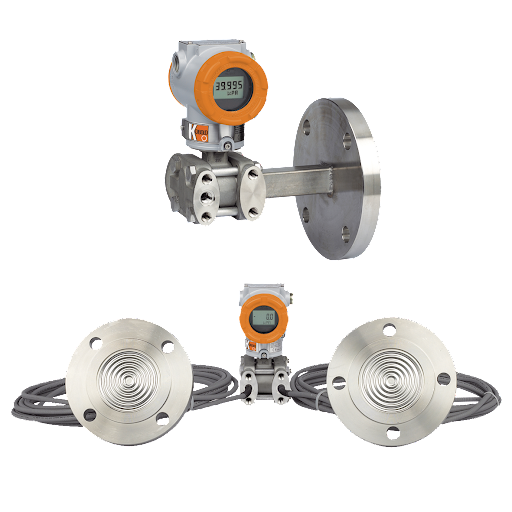
Fig 5. A DP transmitter
Comparing Absolute, Gauge, and Differential Pressure Transmitters
Comparing based on the working principle
Pressure transmitters, including Absolute Pressure Transmitters, Gauge Pressure Transmitters, and Differential Pressure Transmitters, operate based on different working principles. Here's a comparison of these pressure transmitter types based on their working principles:
Absolute Pressure Transmitter:
Gauge Pressure Transmitter:
Differential Pressure Transmitter:
Comparing table
Here's a comparative table summarizing the key differences between Absolute Pressure Transmitters, Gauge Pressure Transmitters, and Differential Pressure Transmitters based on various aspects:
Table 1. Comparison based on the working principle
| Aspect | Absolute Pressure Transmitter | Gauge Pressure Transmitter | Differential Pressure Transmitter |
| Pressure Reference Point | Perfect Vacuum (Absolute Zero) | Local Atmospheric Pressure | Two Reference Points |
| Reading Includes Atmosphere | Yes | No | No |
| Atmospheric Pressure Impact | None | Yes | None |
| Common Applications | - Meteorology - Altitude Measurement - Scientific Experiments - Certain Industrial Processes | - Industrial Monitoring - Pressure Safety - HVAC Systems - Automotive (e.g., tire pressure monitoring) | - Flow Rate Measurement - Level Measurement - Filter Monitoring - Differential Pressure Control |
| Units of Measurement | pascals (Pa), bar, psi, mmHg, etc. | psi, bar, kPa, etc. | psi, bar, kPa, etc. |
| Atmospheric Pressure Variations Compensation | No | No | No (Not impacted directly by atmospheric changes) |
This table provides a clear comparison of the three types of pressure transmitters, highlighting their unique characteristics and common applications. The choice between these transmitters depends on the specific requirements of the application and whether you need pressure measurements relative to a vacuum, local atmospheric pressure, or the difference between two reference points.
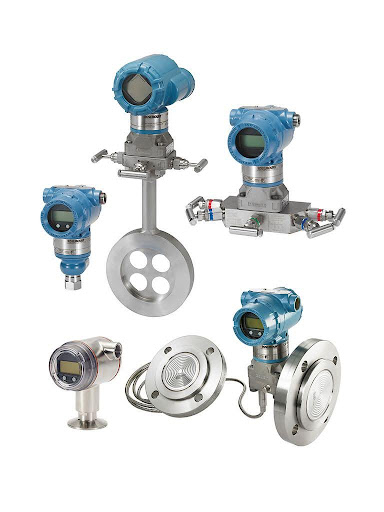
Fig 6. Different Pressure transmitters
Comparing based on the Application
Each type of pressure transmitter—Absolute Pressure Transmitters, Gauge Pressure Transmitters, and Differential Pressure Transmitters—has specific applications where they are most suitable due to their unique characteristics. Here's a comparison based on typical applications for each type:
Absolute Pressure Transmitters:
- Meteorology: Used in weather stations to measure atmospheric pressure and predict weather patterns.
- Altitude Measurement: Used in aviation and aerospace to determine altitude above sea level.
- Scientific Experiments: Employed in laboratories for precise pressure measurements in experiments.
- Certain Industrial Processes: Utilized in processes where measuring absolute pressure is essential, such as vacuum systems and chemical reactions under specific pressure conditions.
Gauge Pressure Transmitters:
- Industrial Monitoring: Widely used in industrial settings to monitor and control processes, such as in pipelines, tanks, and pneumatic systems.
- Pressure Safety: Ensures that pressure levels in systems remain within safe operating ranges.
- HVAC Systems: Monitors and controls air and refrigerant pressures in heating, ventilation, and air conditioning systems.
- Tire Pressure Monitoring: Used in vehicles to indicate when tire pressure is too low (TPMS).
Differential Pressure Transmitters:
- Flow Rate Measurement: Used in pipes and ducts to determine flow rates by measuring the pressure difference caused by obstructions like orifice plates or venturi tubes.
- Level Measurement: Applied in-tank and vessel level measurements to monitor the pressure difference between the bottom of the tank and a reference point.
- Filter Monitoring: Monitors the clogging or saturation of filters in HVAC systems and industrial filtration units.
- Differential Pressure Control: Maintains a specific pressure difference between two areas, such as in cleanrooms or containment facilities.
Comparing table
Here's a comparative table that summarizes the key differences between Absolute Pressure Transmitters, Gauge Pressure Transmitters, and Differential Pressure Transmitters based on their typical applications:
Table 2. Comparison based on the Application
| Application | Absolute Pressure Transmitter | Gauge Pressure Transmitter | Differential Pressure Transmitter |
| Meteorology | ✓ | ||
| Altitude Measurement | ✓ | ||
| Scientific Experiments | ✓ | ||
| Industrial Processes | ✓ | ✓ | |
| Industrial Monitoring | ✓ | ✓ | |
| Pressure Safety | ✓ | ||
| HVAC Systems | ✓ | ||
| Automotive (e.g., TPMS) | ✓ | ||
| Flow Rate Measurement | ✓ | ||
| Level Measurement | ✓ | ||
| Filter Monitoring | ✓ | ||
| Differential Pressure Control | ✓ |
Note: In the table, "✓" indicates the primary suitability of each pressure transmitter type for a specific application. However, there can be some overlap in applications, and the choice of transmitter may depend on the specific requirements and preferences of the user.
Keep in mind that while this table provides a general overview of common applications, individual situations may vary, and other factors, such as the pressure range, accuracy requirements, and environmental conditions, should also be considered when selecting the appropriate pressure transmitter for a given application.
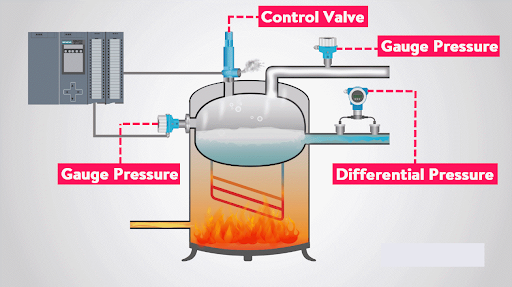
Fig 7. Pressure sensor application
Comparing based on the pressure range
Pressure transmitters are designed to operate within specific pressure ranges, and the choice of the right type depends on the application's pressure requirements. Here's a comparison of Absolute Pressure Transmitters, Gauge Pressure Transmitters, and Differential Pressure Transmitters based on pressure range considerations:
Absolute Pressure Transmitters:
- Pressure Range: Absolute pressure transmitters can measure pressures below atmospheric pressure (vacuum) and extend to higher pressures, depending on the specific design and calibration. They are often used for very low-pressure measurements in the millibar or pascal range to high-pressure measurements in bar or psi ranges.
- Suitable Applications: Ideal for applications that require the measurement of both sub-atmospheric and super-atmospheric pressures, such as vacuum processes, altimeter instruments, and scientific experiments.
Gauge Pressure Transmitters:
- Pressure Range: Gauge pressure transmitters are generally designed to measure pressures above atmospheric pressure. The pressure range can vary widely, from a few psi (for low-pressure applications) to several thousand psi (for high-pressure applications). The specific range depends on the transmitter's design and calibration.
- Suitable Applications: Commonly used in applications where the pressure is above atmospheric pressure, such as in industrial monitoring, HVAC systems, and automotive tire pressure monitoring (TPMS).
Differential Pressure Transmitters:
- Pressure Range: The pressure range of differential pressure transmitters depends on the specific application. They are often used to measure relatively low-pressure differentials, ranging from a fraction of an inch of water column (inH2O) to a few thousand psi. The choice of range depends on the specific use case and the pressure difference to be measured.
- Suitable Applications: Used in applications where monitoring the pressure difference between two points is crucial. The pressure range is selected based on specific requirements, such as flow rate measurement, level measurement, and filter monitoring.
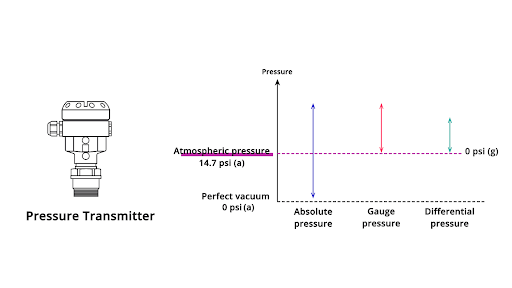
Fig 8. Absolut, Gauge, and Differential Pressure
Comparing based on installation and maintenance
The installation and maintenance requirements for pressure transmitters can vary depending on the type and specific application. Here's a comparison of Absolute Pressure Transmitters, Gauge Pressure Transmitters, and Differential Pressure Transmitters based on these considerations:
Absolute Pressure Transmitters:
- Installation:
- Installation can be straightforward in many cases, as they are mounted in a location where atmospheric pressure is always accessible.
- For accurate measurements, they may require calibration adjustments to account for variations in atmospheric pressure.
- Maintenance:
- Maintenance requirements are generally low because they do not directly reference atmospheric pressure.
- Periodic calibration and testing may be necessary to ensure accurate absolute pressure measurements.
Gauge Pressure Transmitters:
- Installation:
- Installation often involves mounting the transmitter at the desired measurement point, ensuring that the reference chamber is open to the local atmosphere.
- Proper installation and calibration are crucial to account for changes in local atmospheric pressure, especially in applications where accuracy is critical.
- Maintenance:
- Maintenance can be moderate, as gauge pressure transmitters need occasional calibration to compensate for fluctuations in atmospheric pressure.
- Routine inspection and recalibration may be required to maintain accuracy, particularly in critical applications.
Differential Pressure Transmitters:
- Installation:
- Installation may be more complex, as these transmitters require connection to two different reference points within the system.
- Proper installation, including tubing and port connections, is essential to ensure accurate differential pressure measurements.
- Maintenance:
- Maintenance requirements can vary widely based on the application and the system's characteristics.
- Regular inspection, cleaning, and calibration may be needed, especially in applications where precision is crucial for process control or safety.
Comparing table
Here's a comparative table summarizing the installation and maintenance considerations for Absolute Pressure Transmitters, Gauge Pressure Transmitters, and Differential Pressure Transmitters:
Table 3. Comparison based on the Installation
| Aspect | Absolute Pressure Transmitter | Gauge Pressure Transmitter | Differential Pressure Transmitter |
| Installation Simplicity | Moderate to Simple | Moderate to Simple | Moderate to Complex |
| Calibration for Atmospheric Pressure | Occasional adjustment to account for atmospheric pressure variations | Requires regular calibration to compensate for atmospheric pressure changes | Calibration is needed to maintain accuracy, but not directly affected by atmospheric pressure |
| Maintenance Requirements | Generally low | Moderate | Variable (depends on application) |
Please note that the actual installation and maintenance requirements may vary depending on the specific model of the pressure transmitter, the application, and the manufacturer's recommendations. It's important to follow the manufacturer's guidelines and industry best practices to ensure accurate and reliable pressure measurements and transmitter performance.
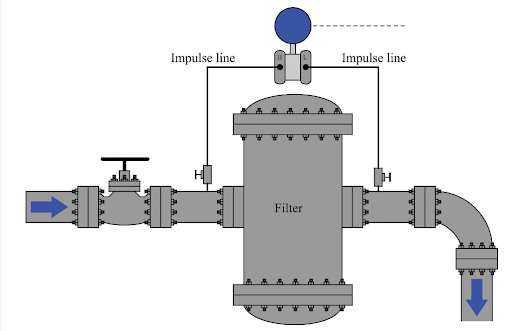
Fig 9. Differential pressure transmitter installation
Pressure transmitters come in various types, each suited to different applications and operating principles. Here's a comparison of Absolute Pressure Transmitters, Gauge Pressure Transmitters, and Differential Pressure Transmitters based on their types:
Absolute Pressure Transmitters:
Types:
Applications by Type:
Gauge Pressure Transmitters:
Applications by Type:
Differential Pressure Transmitters:
- Differential pressure transmitters are primarily used in applications where the focus is on measuring the pressure difference between two reference points. The type chosen depends on the specific requirements, accuracy, and pressure range.
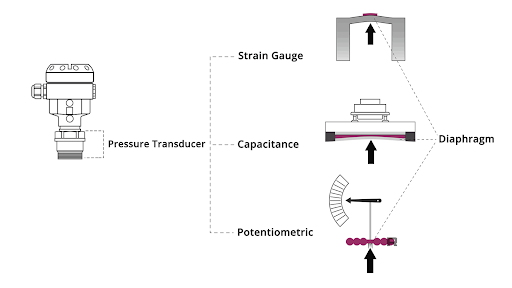
Fig 10. Different types of pressure sensor
Comparing based on Advantages
Each type of pressure transmitter—Absolute Pressure Transmitters, Gauge Pressure Transmitters, and Differential Pressure Transmitters—comes with its unique advantages depending on the application's requirements. Here's a comparison of these pressure transmitter types based on their advantages:
Absolute Pressure Transmitters:
- Advantages:
- Provides the absolute pressure value, which includes both the pressure of the medium and atmospheric pressure.
- Useful for applications where it's essential to know the total pressure, such as meteorology and altitude measurement.
- Allows for accurate measurements in vacuum processes and specific scientific experiments.
- Not directly affected by variations in atmospheric pressure, making it ideal for some laboratory settings.
Gauge Pressure Transmitters:
- Advantages:
- Well-suited for applications where pressure measurements are made relative to local atmospheric conditions.
- Often used in industrial monitoring, HVAC systems, and automotive tire pressure monitoring (TPMS).
- The simplicity of operation and easy installation in many cases.
- Cost-effective and readily available for a wide range of pressure measurement needs.
Differential Pressure Transmitters:
- Advantages:
- Provides precise measurements of pressure differences between two points within a system.
- Valuable for flow rate measurement, level measurement, and filter monitoring.
- Used in applications where the pressure difference is more critical than the absolute pressure.
- Offers high accuracy in measuring pressure differentials.
Ultimately, the choice of pressure transmitter type depends on the specific application and the information required for accurate pressure measurement. Consider the advantages of each type in the context of your application's needs, and select the one that best aligns with your goals for pressure monitoring.
Comparing table
Here's a comparative table summarizing the advantages of Absolute Pressure Transmitters, Gauge Pressure Transmitters, and Differential Pressure Transmitters:
Table 4. Comparison based on the Advantages
| Aspect | Absolute Pressure Transmitter | Gauge Pressure Transmitter | Differential Pressure Transmitter |
| Provides Absolute Pressure Value | ✓ | ||
| Suitable for Total Pressure Measurement | ✓ | ||
| Not Affected by Atmospheric Pressure Variations | ✓ | ✓ | |
| Simplicity of Installation | ✓ | ||
| Cost-Effective | ✓ | ✓ | |
| Suitable for Industrial Monitoring | ✓ | ✓ | |
| Ideal for Flow Rate Measurement | ✓ | ||
| Precise for Pressure Difference Measurement | ✓ |
Please note that the "✓" indicates the primary advantages of each type, but the choice of transmitter should align with the specific requirements and goals of the application. Selecting the appropriate type ensures accurate and reliable pressure measurements in various industrial, scientific, and commercial settings.
Comparing based on disadvantages
Each type of pressure transmitter—Absolute Pressure Transmitters, Gauge Pressure Transmitters, and Differential Pressure Transmitters—comes with certain disadvantages or limitations depending on the application and operating conditions. Here's a comparison of these pressure transmitter types based on their disadvantages:
Absolute Pressure Transmitters:
- Disadvantages:
- Cannot provide pressure differentials or variations; they only measure absolute pressure.
- Not suitable for applications where pressure variations or fluctuations are critical.
- Typically more complex and expensive than gauge pressure transmitters for common applications.
- Require regular calibration to account for atmospheric pressure changes.
Gauge Pressure Transmitters:
- Disadvantages:
- Measure pressure relative to local atmospheric conditions, making them unsuitable for applications where the absolute pressure value is required.
- Susceptible to changes in atmospheric pressure, which can affect accuracy in some situations.
- It may not be suitable for vacuum or low-pressure applications.
- More susceptible to errors in high-altitude environments with varying atmospheric pressure.
Differential Pressure Transmitters:
- Disadvantages:
- Requires proper installation, which can be more complex than single-point pressure transmitters.
- Limited to measuring pressure differences between two points and may not provide absolute pressure readings.
- Can be costlier and less straightforward to install compared to single-point pressure transmitters.
- May require regular maintenance and calibration to maintain accuracy.
It's important to note that the disadvantages mentioned for each type are not absolute limitations but rather considerations for specific applications. The choice of pressure transmitter type should be made based on the specific requirements and constraints of the application to ensure accurate and reliable pressure measurements.
Comparing table
Here's a comparative table summarizing the disadvantages of Absolute Pressure Transmitters, Gauge Pressure Transmitters, and Differential Pressure Transmitters:
Table 5. Comparison based on Disadvantages
| Aspect | Absolute Pressure Transmitter | Gauge Pressure Transmitter | Differential Pressure Transmitter |
| Limited to Absolute Pressure | ✓ | ||
| Affected by Atmospheric Pressure Variations | May require calibration due to atmospheric pressure changes | Vulnerable to atmospheric pressure fluctuations | Not directly affected by atmospheric pressure |
| Suitable for Vacuum or Low-Pressure Applications | Not ideal for precise measurements in vacuum or low-pressure conditions | ||
| Complexity of Installation | Installation can be more complex due to the need for two reference points | ||
| Calibration Needs | May require periodic calibration to account for atmospheric pressure variations | Regular calibration may be necessary to compensate for atmospheric pressure changes | Calibration may be needed, depending on accuracy requirements |
Please note that the "✓" indicates the primary disadvantages or considerations for each type based on specific aspects. The choice of the transmitter should be made based on the specific requirements and constraints of the application to ensure accurate and reliable pressure measurements.
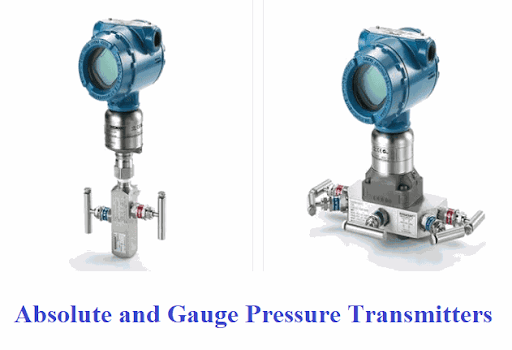
Fig 11. Absolute and Gauge pressure transmitters
Comparing based on easy-to-use
The ease of use of pressure transmitters can vary depending on the type and application. Here's a comparison of Absolute Pressure Transmitters, Gauge Pressure Transmitters, and Differential Pressure Transmitters based on their ease of use:
Absolute Pressure Transmitters:
Gauge Pressure Transmitters:
- Ease of Use:
- Often considered user-friendly due to their installation simplicity in applications that measure pressure relative to atmospheric conditions.
- May require regular calibration to compensate for atmospheric pressure variations, which can be a maintenance consideration.
- Well-suited for applications where monitoring pressure relative to the local environment is necessary.
- Widely available and cost-effective for a variety of common pressure measurement needs.
Differential Pressure Transmitters:
- Ease of Use:
- Installation can be more complex than single-point pressure transmitters because they require connection to two reference points within the system.
- Proper installation, including tubing and port connections, is essential for accurate measurements.
- Calibration may be required, depending on the application's accuracy needs.
- Valuable for applications where monitoring pressure differences between two points is crucial.
In summary, the ease of use for each type of pressure transmitter depends on the specific application and the user's familiarity with the equipment. Absolute pressure transmitters may be easier for some applications, gauge pressure transmitters are user-friendly in many cases, and differential pressure transmitters require careful installation but offer valuable pressure difference measurements. The choice should align with the specific requirements and the user's experience with pressure measurement equipment.
Comparing table
Here's a comparative table summarizing the ease of use for Absolute Pressure Transmitters, Gauge Pressure Transmitters, and Differential Pressure Transmitters:
Table 6. Comparison based on the Easy to use
| Aspect | Absolute Pressure Transmitter | Gauge Pressure Transmitter | Differential Pressure Transmitter |
| Ease of Installation | Generally straightforward for applications requiring absolute pressure measurements | Often user-friendly due to installation simplicity for gauge pressure monitoring | Installation can be more complex due to the requirement for two reference points |
| Calibration Needs | Periodic calibration may be needed to account for atmospheric pressure variations | Regular calibration may be necessary to compensate for atmospheric pressure changes | Calibration may be required, depending on accuracy requirements |
| Susceptibility to Atmospheric Changes | Generally less affected by atmospheric pressure changes | Affected by variations in atmospheric pressure | Not directly affected by atmospheric pressure |
| Suitable for Absolute Pressure Measurement | ✓ | ||
| Suitable for Relative Pressure Measurement | ✓ | ||
| Suitable for Differential Pressure Measurement | ✓ |
Please note that the "✓" indicates the primary advantage or suitability for each type based on ease of use, but the choice of the transmitter should be made based on the specific requirements and constraints of the application to ensure accurate and user-friendly pressure measurements.
Factors influencing the selection between these types
The selection of a pressure transmitter type—whether Absolute Pressure Transmitter, Gauge Pressure Transmitter, or Differential Pressure Transmitter—depends on various factors. These factors influence the choice and are essential for ensuring the transmitter is well-suited to the application. Here are the key factors that influence the selection:
In summary, the selection of a pressure transmitter type is a multi-faceted decision that depends on the specific requirements and constraints of the application. Carefully evaluating these factors and their relative importance will lead to the most appropriate choice for accurate and reliable pressure measurements.
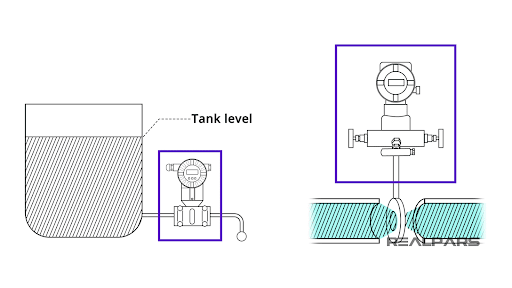
Fig 12. Differential pressure transmitter used in tank
Real-world examples and scenarios for choosing the appropriate type
Selecting the appropriate type of pressure transmitter—Absolute, Gauge, or Differential—depends on the specific requirements and conditions of real-world applications. Here are some real-world examples and scenarios for choosing the right type:
Meteorological Station:
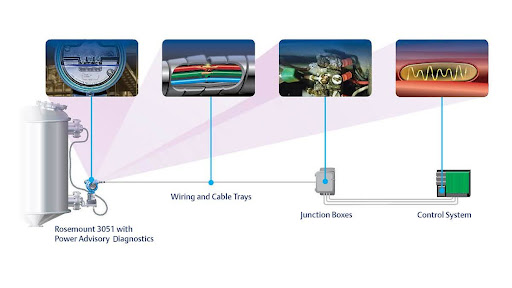
Fig 13. Rosemount pressure transmitters
Conclusion
In this comprehensive guide on pressure transmitters, we have explored the various types—Absolute Pressure Transmitters, Gauge Pressure Transmitters, and Differential Pressure Transmitters—along with their working principles, applications, advantages, disadvantages, and the factors influencing their selection. Let's summarize the key takeaways:
- Working Principles: Each pressure transmitter type operates on distinct principles. Absolute pressure measures pressure relative to a perfect vacuum, gauge pressure measures relative to local atmospheric pressure, and differential pressure measures the pressure difference between two reference points.
- Applications: The choice of pressure transmitter type depends on the specific application. Absolute pressure transmitters are suited for meteorology, altitude measurement, and scientific experiments. Gauge pressure transmitters find use in industrial monitoring, HVAC systems, and automotive tire pressure monitoring. Differential pressure transmitters excel in flow rate measurement, level measurement, and filter monitoring.
- Advantages: Each type offers its unique advantages. Absolute pressure transmitters provide absolute pressure values, gauge pressure transmitters are user-friendly in many applications, and differential pressure transmitters offer precise measurements of pressure differences.
- Disadvantages: It's essential to consider the disadvantages when selecting a pressure transmitter. Absolute pressure transmitters may require calibration for atmospheric pressure changes, gauge pressure transmitters are vulnerable to atmospheric pressure fluctuations, and differential pressure transmitters can have complex installations.
- Selection Factors: The choice of pressure transmitter type is influenced by factors such as measurement requirements, pressure range, accuracy needs, environmental conditions, installation and maintenance complexity, budget considerations, regulatory compliance, and more.
- Real-World Scenarios: Real-world examples helped illustrate how different pressure transmitter types are applied in various industries and applications. Selecting the appropriate type is crucial for accurate and reliable pressure measurements.
In conclusion, the selection of the right pressure transmitter type is a critical decision that depends on a thorough understanding of the application's unique requirements and constraints. By carefully considering these factors, users can ensure that pressure measurements are accurate, reliable, and suitable for their real-world applications, ultimately contributing to safety, efficiency, and precision in a wide range of industries and contexts.
To recap
1. What is a pressure transmitter?
A pressure transmitter is a device used to measure and convert pressure into an electrical signal, making it easier to monitor, control, or record pressure values.
2. What are the main types of pressure transmitters?
The main types of pressure transmitters are Absolute Pressure Transmitters, Gauge Pressure Transmitters, and Differential Pressure Transmitters.
3. How does an Absolute Pressure Transmitter work?
Absolute Pressure Transmitters measure pressure relative to an absolute vacuum. They typically use sealed reference chambers to measure pressure without any reference to atmospheric conditions.
4. Where are Gauge Pressure Transmitters commonly used?
Gauge Pressure Transmitters are often used in applications where pressure measurements are relative to local atmospheric conditions. Common uses include industrial monitoring, HVAC systems, and tire pressure monitoring in vehicles.
5. What is the primary advantage of Differential Pressure Transmitters?
Differential Pressure Transmitters are ideal for measuring pressure differences between two reference points. Their primary advantage is high accuracy in measuring pressure differentials.
6. How do I choose the right pressure transmitter type for my application?
The choice depends on factors like measurement requirements, pressure range, accuracy needs, environmental conditions, installation complexity, budget constraints, and the application type. Evaluate these factors to make an informed choice.
7. Are there any disadvantages to using an Absolute Pressure Transmitter?
Yes, one disadvantage is that they do not provide information about pressure variations or pressure differences. They also require calibration for atmospheric pressure changes in some applications.
8. What kind of applications require Differential Pressure Transmitters?
Applications that require monitoring pressure differences between two points within a system benefit from Differential Pressure Transmitters. Examples include flow rate measurement, level measurement, and filter monitoring.
9. Do pressure transmitters need regular maintenance?
The maintenance requirements depend on the specific application and the type of pressure transmitter. Some may require periodic calibration and maintenance, while others may have lower maintenance needs.
10. What is the main goal of selecting the appropriate pressure transmitter type?
The primary goal is to ensure accurate and reliable pressure measurements in real-world applications. Selecting the right type is essential for safety, efficiency, and precision in various industries and contexts.
References
https://realpars.com/pressure-transmitter/
http://www.calscan.net/school_pressure_modes.html
https://www.nuovafima.com/en/prodotti/mtom-dn100-en/
https://heinrichs.eu/en/products/pressure/differential-pressure-transmitter-pad/
Recent Posts
-
Booster Pump Troubleshooting and Maintenance: How to Fix and Prevent Common Issues
1. Introduction Imagine turning on your faucet only to be greeted with a weak trickle of water when …22nd Apr 2025 -
Energy-Efficient Booster Pumps: Selection and Tips for Maximizing Performance
1. Introduction Imagine never having to deal with fluctuating water pressure, noisy pumps, or skyroc …19th Apr 2025 -
Booster Pumps for Sustainable Water Systems: Irrigation and Rainwater Harvesting Solutions
1. Introduction Water scarcity is no longer a distant threat—it’s a reality affecti …16th Apr 2025

